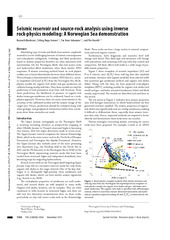Seismic reservoir and source-rock analysis using inverse rock-physics modeling: A Norwegian Sea demonstration
Peer reviewed, Journal article
Published version

Åpne
Permanent lenke
https://hdl.handle.net/1956/15677Utgivelsesdato
2015-11Metadata
Vis full innførselSamlinger
- Department of Earth Science [1103]
Originalversjon
https://doi.org/10.1190/tle34111350.1Sammendrag
Identifying type of rocks and fluids from seismic-amplitude anomalies can be challenging because of seismic nonuniqueness and rock-physics ambiguities. Lithology and fluid predictions based on seismic properties therefore are often associated with uncertainties. On the Norwegian Shelf, clay-rich source rocks and hydrocarbon-filled sandstones often show similar AVO responses. A seismic screening method based on rock physics enables one to better discriminate between these different facies. This technique is demonstrated on seismic AVO data (i.e., acoustic impedance [AI] and VP/VS) from the Norwegian Sea. Rock-physics models for organic-rich shales and gas sandstones are calibrated using nearby well data. Then these models are used for predictions of rock parameters away from well locations. From these predictions, the likelihood of presence of organic-rich shales versus gas sandstones can be evaluated, based on a rock-physics approach. However, there are many uncertainties in the accuracy of the calibrated models and the seismic image of the target area. Hence, predictions should be evaluated along with other geologic and geophysical information before firm conclusions about these anomalies are made.